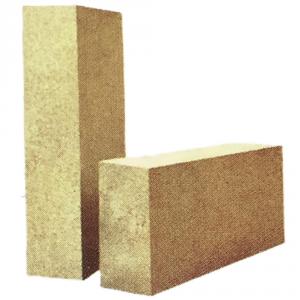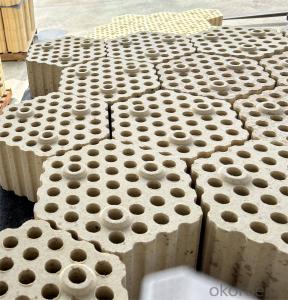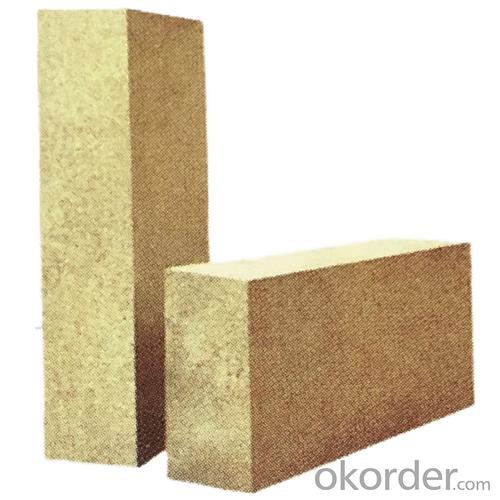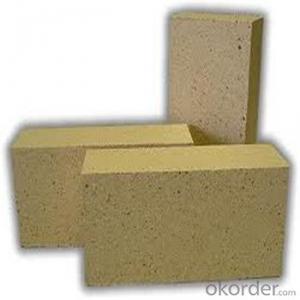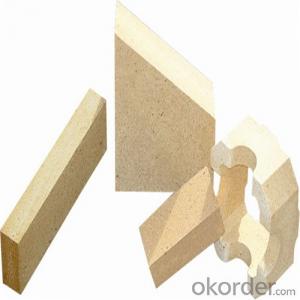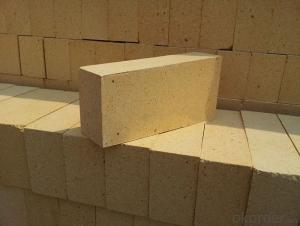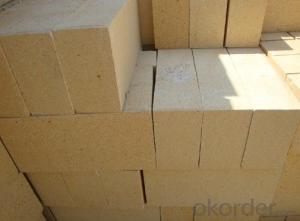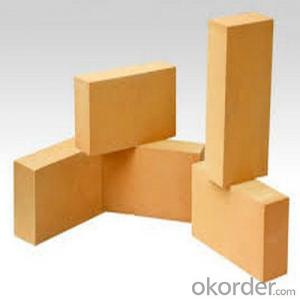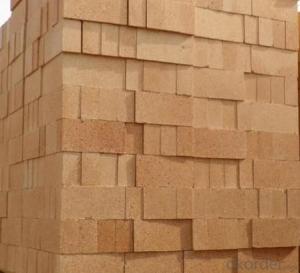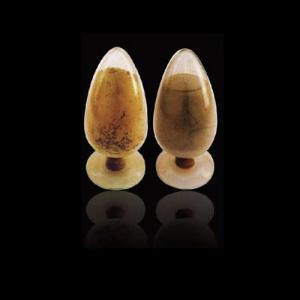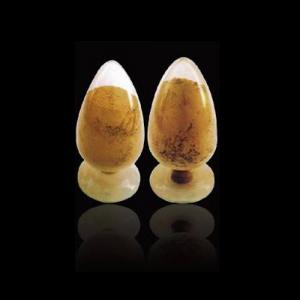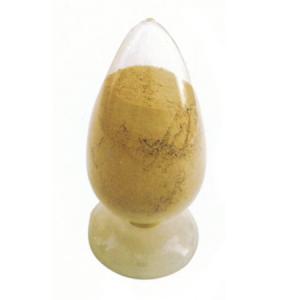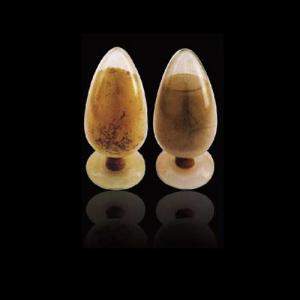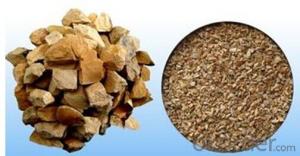Fireclay Brick for Blast Furnace Hot Blast Furnace Monolithic Refractory RN-40 RN-42
- Loading Port:
- China main port
- Payment Terms:
- TT or LC
- Min Order Qty:
- 24 m.t.
- Supply Capability:
- 6000 m.t./month
OKorder Service Pledge
OKorder Financial Service
You Might Also Like
-Fireclay Bricks for Blast Furnace
Fireclay bricks for blast furnaces help to maintain the integrity of blast furnace.
Those fireclay bricks can withstand long-time corrosion of slag and chemical.
Besides, the fire clay refractory brick can reduce the deposition of carbon in the pores, which avoids brick expansion and loose damage during use.
-Fire Clay Bricks for Hot Blast Stoves
Fireclay bricks for hot blast stoves have great resistance to thermal shock, high load-bearing capacity, and minimal creep.
This kind of bricks used in the chamber and walls of hot blast stoves.

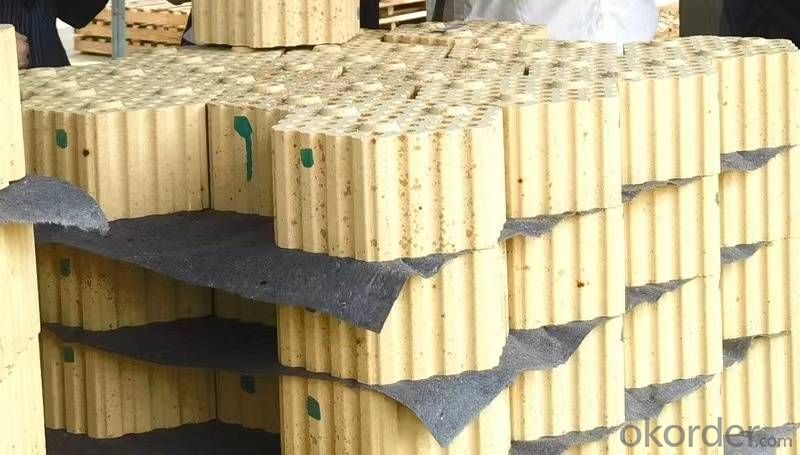
- Q: How do monolithic refractories withstand high temperatures and thermal cycling?
- Monolithic refractories are designed to withstand high temperatures and thermal cycling due to their unique composition and structural characteristics. Firstly, monolithic refractories are made from high-quality raw materials, such as alumina, silica, and magnesia, which have excellent thermal properties. These materials possess high melting points and low thermal conductivity, allowing them to retain their strength and integrity even at extreme temperatures. Moreover, monolithic refractories are typically engineered to have a dense and compact microstructure. This dense structure prevents the penetration of heat and gases, thus minimizing thermal shock and preventing the formation of cracks. Additionally, the compact microstructure enhances the refractory's thermal conductivity, enabling it to efficiently distribute and dissipate heat. Furthermore, monolithic refractories are often formulated with special additives and bonding agents that enhance their resistance to thermal cycling. These additives can improve the refractory's thermal expansion properties, allowing it to expand and contract without cracking or spalling during rapid temperature changes. Additionally, certain bonding agents can provide a degree of flexibility to the refractory, enabling it to accommodate thermal stresses without compromising its structural integrity. In addition to the inherent characteristics of monolithic refractories, proper installation techniques also play a crucial role in their ability to withstand high temperatures and thermal cycling. The refractory must be carefully applied and cured to ensure uniformity and minimize the formation of internal stresses. Adequate curing and heat treatment processes help to develop a strong and durable bond between the refractory and the substrate, enhancing its resistance to thermal shock and cyclic thermal loading. Overall, monolithic refractories are engineered to withstand high temperatures and thermal cycling through their composition, microstructure, and installation techniques. These factors work in synergy to provide the refractory with excellent thermal conductivity, resistance to thermal shock, and the ability to expand and contract without compromising its structural integrity.
- Q: What are the advantages of using low-cement castables in the iron and steel industry?
- There are several advantages of using low-cement castables in the iron and steel industry. Firstly, low-cement castables have a lower water content, which leads to better refractoriness and higher strength, enabling them to withstand high temperatures and thermal shocks experienced in iron and steel manufacturing processes. Secondly, low-cement castables exhibit excellent flowability and workability, allowing for easier installation and shaping. This results in reduced labor and time required for installation, leading to cost savings. Moreover, low-cement castables have a reduced porosity, which enhances their resistance to slag and metal penetration during the iron and steel production processes. This property improves the lining's durability and extends its service life, reducing maintenance and downtime. Additionally, low-cement castables offer superior mechanical properties, such as higher abrasion resistance and better thermal conductivity, making them ideal for various applications in the iron and steel industry, including ladles, tundishes, and blast furnaces. Overall, the advantages of using low-cement castables in the iron and steel industry include enhanced refractoriness, increased strength, improved workability, reduced porosity, and superior mechanical properties, ultimately resulting in improved efficiency, cost-effectiveness, and longer-lasting linings.
- Q: What are the typical operating temperatures for monolithic refractories?
- The typical operating temperatures for monolithic refractories vary depending on the specific composition and type of refractory material. However, in general, monolithic refractories are designed to withstand high temperatures ranging from 1500°C (2732°F) to 1800°C (3272°F) and even higher in some cases. These refractories are commonly used in industries such as steelmaking, cement production, glass manufacturing, and petrochemical processing, where they are subjected to extreme thermal conditions. Different types of monolithic refractories have different temperature limits. For instance, basic refractories made of magnesia or dolomite can withstand temperatures up to 1800°C (3272°F). On the other hand, alumina-based refractories can typically handle temperatures up to 1700°C (3092°F). Silicon carbide-based refractories have even higher temperature resistance, with the ability to withstand temperatures above 2000°C (3632°F). It is crucial to select the appropriate monolithic refractory material based on the specific operating temperature requirements of the application. Using refractories beyond their recommended temperature limits can cause thermal shock, spalling, or reduced performance, leading to potential equipment failure or safety hazards. Therefore, consulting with refractory manufacturers or experts in the field is essential to ensure the correct selection and optimal performance of monolithic refractories in high-temperature applications.
- Q: What are the key properties of shotcrete mixes used for monolithic refractory applications?
- The key characteristics of shotcrete mixes utilized in monolithic refractory applications are as follows: 1. Strong: Shotcrete mixes for monolithic refractory applications must possess a high level of compressive strength in order to withstand the intense temperatures and stresses endured in refractory environments. This ensures that the shotcrete lining remains intact and provides effective insulation and protection. 2. Minimal Porosity: Shotcrete mixes should exhibit low porosity to minimize the infiltration of gases and liquids into the refractory lining. This is crucial in preventing corrosion and degradation of the lining, ensuring its long-lasting durability. 3. Thermal Stability: Shotcrete mixes must demonstrate exceptional thermal stability to endure the extreme heat conditions encountered in refractory applications. They should also possess low thermal conductivity to effectively insulate the structure and prevent heat transfer, thus preserving the integrity of the refractory lining and optimizing its performance. 4. Resistant to Wear and Tear: Shotcrete mixes used in monolithic refractory applications should have high resistance to abrasion, enabling them to withstand the mechanical wear caused by the movement of materials and particles. This property ensures that the refractory lining remains intact and provides effective protection against erosion. 5. Resistant to Chemicals: Shotcrete mixes should be resistant to chemical attacks from molten metals, slag, and other corrosive substances commonly found in refractory applications. This resistance helps to maintain the integrity of the lining and extend its service life. 6. Easy to Work with: Shotcrete mixes should exhibit good workability to facilitate easy placement and application. This allows for efficient and precise installation of the refractory lining, ensuring the desired thickness and coverage. In summary, shotcrete mixes utilized in monolithic refractory applications must possess a combination of high strength, low porosity, thermal stability, abrasion resistance, chemical resistance, and workability in order to guarantee optimal performance and durability in refractory environments.
- Q: How do monolithic refractories perform in reheating furnace roof applications?
- Monolithic refractories perform exceptionally well in reheating furnace roof applications due to their superior thermal shock resistance, high strength, and excellent resistance to chemical attack at high temperatures. These refractories provide a reliable and durable lining that can withstand the extreme conditions of reheating furnaces, ensuring efficient heat transfer, reduced maintenance, and prolonged furnace life.
- Q: How do monolithic refractories enhance the performance of ladle and tundish preheating systems?
- Monolithic refractories enhance the performance of ladle and tundish preheating systems by providing excellent thermal insulation, high mechanical strength, and resistance to corrosion and erosion. This allows for efficient heat retention and distribution, ensuring uniform and consistent preheating of ladles and tundishes. Additionally, monolithic refractories minimize heat losses, reduce energy consumption, and increase the lifespan of the preheating systems, contributing to improved overall performance.
- Q: How do monolithic refractories withstand thermal shock?
- Monolithic refractories possess unique properties and composition that enable them to endure thermal shock. Thermal shock occurs when there is a sudden alteration in temperature, leading to stress and potential damage to the refractory material. However, monolithic refractories are constructed to possess high resistance to thermal shock, and this is accomplished through various mechanisms. Firstly, the composition of monolithic refractories incorporates materials with low coefficients of thermal expansion. This implies that they undergo minimal alterations in size or volume when exposed to varying temperatures. This characteristic allows the refractory material to withstand thermal shock by minimizing the stress caused by temperature fluctuations. Secondly, monolithic refractories exhibit exceptional thermal conductivity. This quality enables them to efficiently transfer heat away from the hot regions, preventing localized overheating and diminishing the likelihood of thermal shock. The rapid dissipation of heat aids in maintaining a more even distribution of temperature within the refractory material, thereby reducing the chances of cracking or spalling. Furthermore, the binding agents employed in monolithic refractories play a vital role in enhancing their resistance to thermal shock. These binders provide strength to the refractory material and assist in preserving its integrity during thermal cycling. Additionally, the binders contribute to the refractory's ability to withstand thermal shock by reducing the permeability of the material, thus preventing the infiltration of hot gases or liquids that could cause damage. Moreover, the installation technique of monolithic refractories plays a significant role in their capacity to endure thermal shock. Typically, monolithic refractories are applied as a single, uninterrupted layer, eliminating the weak points such as joints and seams that exist in other refractory systems. This seamless installation method ensures superior resistance to thermal shock as there are no vulnerable points for cracks to propagate. In conclusion, monolithic refractories effectively withstand thermal shock through a combination of factors including their low coefficients of thermal expansion, high thermal conductivity, appropriate binding agents, and seamless installation techniques. These properties and design considerations enable monolithic refractories to proficiently handle rapid temperature changes and maintain their structural integrity, making them ideal for applications involving thermal cycling and extreme variations in temperature.
- Q: What are the advantages of using monolithic refractories in electric arc furnaces?
- There are several advantages to using monolithic refractories in electric arc furnaces. Firstly, monolithic refractories offer excellent thermal shock resistance. Electric arc furnaces operate at extremely high temperatures, and the refractory lining is constantly exposed to rapid temperature changes. Monolithic refractories are able to withstand this thermal cycling without cracking or deteriorating, ensuring the longevity and efficiency of the furnace. Secondly, monolithic refractories have superior corrosion resistance. Electric arc furnaces often use aggressive slag compositions, which can corrode and erode traditional brick linings. Monolithic refractories, on the other hand, are specifically designed to resist chemical attack, providing long-lasting protection against the corrosive effects of molten metal and slag. Additionally, monolithic refractories offer great flexibility in terms of installation. Unlike brick linings, which require extensive labor and time to construct, monolithic refractories can be easily applied as a liquid or paste, allowing for faster and more efficient installation. This not only reduces downtime during furnace maintenance or repairs but also provides the opportunity for customized linings to be easily created to suit specific furnace designs. Moreover, monolithic refractories have excellent thermal conductivity. This property allows for efficient heat transfer within the electric arc furnace, ensuring optimal energy use and minimizing heat losses. This improved thermal efficiency results in reduced operating costs and increased productivity. Furthermore, monolithic refractories have a high refractoriness, meaning they can withstand extremely high temperatures without deformation or failure. This is crucial for electric arc furnaces, which operate at temperatures exceeding 3000°C. The ability of monolithic refractories to maintain their structural integrity at such extreme temperatures ensures the safe and efficient operation of the furnace. In conclusion, the advantages of using monolithic refractories in electric arc furnaces include their thermal shock resistance, corrosion resistance, ease of installation, high thermal conductivity, and exceptional refractoriness. These properties contribute to improved furnace performance, increased productivity, reduced operating costs, and extended furnace life.
- Q: Can monolithic refractories be used for the lining of reheating furnaces and walking beam furnaces?
- Monolithic refractories, which are refractory materials that can be cast or gunned into place rather than being made up of individual bricks or precast shapes, can be utilized for the lining of both reheating furnaces and walking beam furnaces. This characteristic makes them highly adaptable and versatile for a variety of furnace applications. Reheating furnaces are employed to heat metal products to a specific temperature before undergoing further processing, such as rolling or forging. The lining of these furnaces is exposed to high temperatures, thermal cycling, and mechanical stress. Given their exceptional thermal shock resistance and ability to withstand rapid temperature changes without cracking or spalling, monolithic refractories are well-suited for these conditions. In the steel industry, walking beam furnaces are utilized for the continuous heating and transportation of steel slabs or billets. These furnaces necessitate a lining material that can endure the abrasion and mechanical stress caused by the movement of the material. Monolithic refractories with high abrasion resistance and good mechanical strength are ideal for lining walking beam furnaces. Moreover, monolithic refractories provide additional advantages such as straightforward installation, decreased downtime for repairs, and enhanced energy efficiency. They can be customized to fit specific furnace designs and can be easily repaired or replaced as needed. In conclusion, monolithic refractories are a suitable option for lining reheating furnaces and walking beam furnaces due to their ability to withstand high temperatures, thermal cycling, mechanical stress, and abrasion. Their versatility, ease of installation, and repair make them the preferred choice for these furnace applications.
- Q: What are the advantages of using monolithic refractories in the iron and steel industry?
- There are several advantages of using monolithic refractories in the iron and steel industry. Firstly, monolithic refractories offer excellent thermal insulation properties. This means that they are able to withstand and retain high temperatures, which is crucial in the iron and steel manufacturing process. The ability to withstand extreme heat ensures that the refractories maintain their structural integrity, reducing the risk of failure and maintaining operational efficiency. Secondly, monolithic refractories have superior corrosion resistance. In the iron and steel industry, where materials are exposed to harsh chemicals and corrosive agents, the use of monolithic refractories helps to protect the equipment and structures from degradation. This not only extends the lifespan of the refractories but also reduces maintenance costs and downtime. Another advantage of monolithic refractories is their versatility. Unlike traditional refractory bricks, which are rigid and require skilled labor for installation, monolithic refractories can be cast or sprayed into various shapes and sizes. This flexibility allows for easier installation and customization, resulting in better lining design and improved performance. Additionally, monolithic refractories can be easily repaired or patched in case of damage, minimizing production disruptions. Furthermore, monolithic refractories have excellent mechanical strength and abrasion resistance. In the iron and steel industry, where materials are constantly being moved and processed, the refractories must be able to withstand mechanical stresses and abrasion. Monolithic refractories provide the necessary strength and resistance, ensuring that they can withstand the rigors of the industry without compromising performance. Lastly, the use of monolithic refractories in the iron and steel industry can lead to cost savings. Due to their versatility and ease of installation, monolithic refractories require less labor and time for installation, resulting in reduced installation costs. Additionally, their longer lifespan and resistance to corrosion and thermal shock minimize the need for frequent replacements, reducing maintenance and downtime costs. In conclusion, the advantages of using monolithic refractories in the iron and steel industry include excellent thermal insulation, corrosion resistance, versatility, mechanical strength, and cost savings. These benefits make monolithic refractories an ideal choice for lining furnaces, ladles, and other equipment used in the production of iron and steel.
Send your message to us
Fireclay Brick for Blast Furnace Hot Blast Furnace Monolithic Refractory RN-40 RN-42
- Loading Port:
- China main port
- Payment Terms:
- TT or LC
- Min Order Qty:
- 24 m.t.
- Supply Capability:
- 6000 m.t./month
OKorder Service Pledge
OKorder Financial Service
Similar products
Hot products
Hot Searches
Related keywords
